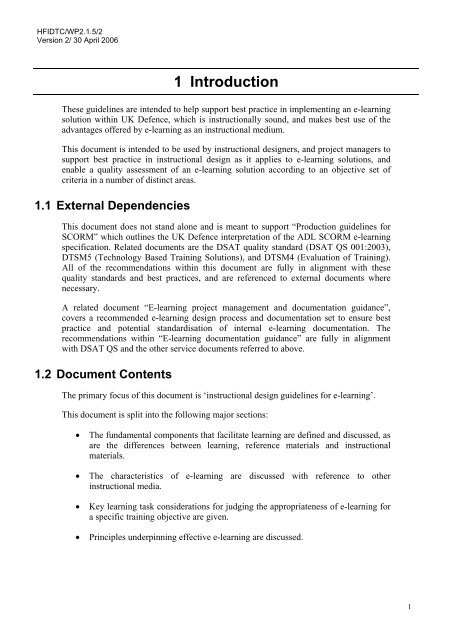E-learning Instructional Design Guidelines - Human Factors ...
E-learning Instructional Design Guidelines - Human Factors ...
E-learning Instructional Design Guidelines - Human Factors ...
Create successful ePaper yourself
Turn your PDF publications into a flip-book with our unique Google optimized e-Paper software.
HFIDTC/WP2.1.5/2<br />
Version 2/ 30 April 2006<br />
1 Introduction<br />
These guidelines are intended to help support best practice in implementing an e-<strong>learning</strong><br />
solution within UK Defence, which is instructionally sound, and makes best use of the<br />
advantages offered by e-<strong>learning</strong> as an instructional medium.<br />
This document is intended to be used by instructional designers, and project managers to<br />
support best practice in instructional design as it applies to e-<strong>learning</strong> solutions, and<br />
enable a quality assessment of an e-<strong>learning</strong> solution according to an objective set of<br />
criteria in a number of distinct areas.<br />
1.1 External Dependencies<br />
This document does not stand alone and is meant to support “Production guidelines for<br />
SCORM” which outlines the UK Defence interpretation of the ADL SCORM e-<strong>learning</strong><br />
specification. Related documents are the DSAT quality standard (DSAT QS 001:2003),<br />
DTSM5 (Technology Based Training Solutions), and DTSM4 (Evaluation of Training).<br />
All of the recommendations within this document are fully in alignment with these<br />
quality standards and best practices, and are referenced to external documents where<br />
necessary.<br />
A related document “E-<strong>learning</strong> project management and documentation guidance”,<br />
covers a recommended e-<strong>learning</strong> design process and documentation set to ensure best<br />
practice and potential standardisation of internal e-<strong>learning</strong> documentation. The<br />
recommendations within “E-<strong>learning</strong> documentation guidance” are fully in alignment<br />
with DSAT QS and the other service documents referred to above.<br />
1.2 Document Contents<br />
The primary focus of this document is ‘instructional design guidelines for e-<strong>learning</strong>’.<br />
This document is split into the following major sections:<br />
• The fundamental components that facilitate <strong>learning</strong> are defined and discussed, as<br />
are the differences between <strong>learning</strong>, reference materials and instructional<br />
materials.<br />
• The characteristics of e-<strong>learning</strong> are discussed with reference to other<br />
instructional media.<br />
• Key <strong>learning</strong> task considerations for judging the appropriateness of e-<strong>learning</strong> for<br />
a specific training objective are given.<br />
• Principles underpinning effective e-<strong>learning</strong> are discussed.<br />
1
















